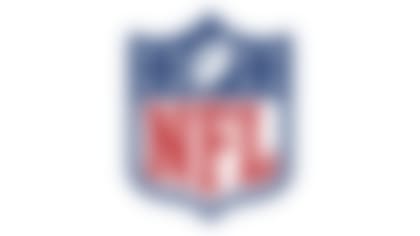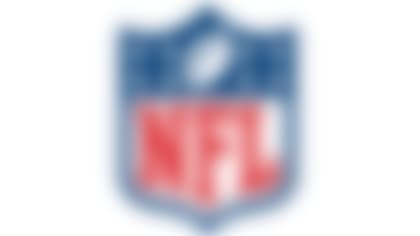Judy Battista served on the 26-person blue-ribbon panel that voted on the NFL's All-Time Team, a collection of the 100 greatest players and 10 greatest coaches in the league's 100-year history. Different positions from this dream team will be revealed each Friday night at 8 p.m. ET on NFL Network through Week 17. Judy will review the selections in this space. This week's reveal included five tight end, seven offensive tackles, seven offensive guards, four centers and four more coaches (joining Bill Belichick, Paul Brown and Chuck Noll among coaches already named):
TIGHT END (5): Mike Ditka, Tony Gonzalez, Rob Gronkowski, John Mackey*, Kellen Winslow.
OFFENSIVE TACKLE (7): Roosevelt Brown, Forrest Gregg, Cal Hubbard, Walter Jones, Anthony Munoz*, Jonathan Ogden, Art Shell.
OFFENSIVE GUARD (7): Larry Allen, Dan Fortmann, John Hannah, Bruce Matthews, Randall McDaniel, Jim Parker*, Gene Upshaw.
CENTER (4): Mel Hein, Jim Otto, Dwight Stephenson, Mike Webster.
HEAD COACH (4): George Halas, Curly Lambeau, Tom Landry, Vince Lombardi.
*Denotes unanimous player selection.
* * * **
"Impossible to defend."
That is what one member of the panel that selected the NFL's All-Time Team said of Rob Gronkowski. It's why the New England Patriots' offense hasn't looked the same since he retired in March. And it's why Gronkowski -- who, at just 30, could theoretically still return to the field for several more seasons -- was one of five tight ends chosen for this illustrious squad.
Gronk's career was relatively brief -- just 115 games over nine seasons -- but his numbers were stunning. And on his signature play, in particular, a catch-and-run down the seam, he was a matchup nightmare. He caught 521 passes for 7,861 yards, an average of 15.1 yards per reception. He had 79 touchdowns and 406 first downs. And Gronkowski blocked -- a throwback to the era when the tight end was virtually an extra lineman who paved the way for the position that was, at that time, the most important offensive weapon: the running back.
Mike Ditka took great pride in blocking for Gale Sayers in the 1960s, and both are on this all-time team. George Halas used to also put some space between the offensive line and Ditka, making Ditka one of the first tight ends to split out a bit and become a receiving threat. As a rookie in 1961, Ditka was the Bears' leading receiver, catching 56 passes for 1,076 yards. In 1964, he caught 75 passes. Even the great John Mackey never had that many grabs in a season, but he is considered the prototype for the big, fast tight ends of the modern game, which also includes other members of the all-time team, Kellen Winslow and Tony Gonzalez, who holds the NFL record for catches and receiving yards by a tight end. Mackey was the only tight end selected to the all-time team unanimously. In 139 games, Mackey had 331 receptions for 5,236 yards, 38 touchdowns and an average of 15.8 yards per reception. Mackey and Ditka were the first two tight ends ever elected to the Pro Football Hall of Fame.
While Gonzalez and Gronkowski gave the tight end class a current tilt, the offensive line is decidedly from a time before unsteady fronts plagued even championship-caliber teams. In recent years, it has become clear that NFL offensive lines are suffering because there is so little traditional run-blocking in the college game, giving incoming O-linemen a steeper learning curve than those who came before them. Consequently, the offensive linemen of the all-time team have a decidedly throwback feel.
No lineman who played in this decade is on the all-time team. Of the 18 tackles, guards and centers named, just five -- tackles Jonathan Ogden and Walter Jones, and guards Larry Allen, Randall McDaniel and Bruce Matthews -- played in the 2000s. The best left tackle in history, the unanimously selected Anthony Munoz, played his last game in 1992. Instead, three -- Cal Hubbard, whose career began in 1927, Dan Fortmann and Mel Hein -- played in the 1930s. The only unanimous pick at guard, Jim Parker, played in the 1950s and '60s. The era of "three yards and a cloud of dust" is well represented. The team is heavy with players from clubs that dominated the 1960s and '70s, with Raiders teammates Art Shell, Jim Otto and Gene Upshaw all on the list.
This episode also revealed the largest group of coaches yet, and each of the four is a household name. The all-time team features only 10 head coaches, and while there are others who received strong consideration and would certainly have made a slightly longer list, the four picks unveiled in this episode might have been among the easiest decisions the selection panel had.
George Halas was, quite literally, there at the creation of the NFL, having attended the meeting at a Canton automobile shop when the NFL was formed in 1920. "Papa Bear" was the influential owner of the Chicago Bears and a coach of 40 years (winning six NFL titles), and his efforts on early promotional barnstorming tours (also attended by his toddler daughter, Virginia -- who now owns her family's team) were critical to generating interest in the fledgling league.
Tom Landry was the coach of the Dallas Cowboys for 29 years. His teams had 20 consecutive winning seasons, won two Super Bowls and five NFC titles. And he created several defensive and offensive innovations. He was a creator of the 4-3 and flex defenses, and he popularized the regular use of the shotgun formation and pre-snap shifts.
Curly Lambeau merely founded the Green Bay Packers and then was an outstanding halfback while serving as a player-coach. For 29 years, he was the coach and general manager, leading the Packers to six championships and more than 200 victories. He was the first Packer to throw a pass, throw a touchdown pass and make a field goal.
One of Lambeau's successors became an even more iconic coach. Vince Lombardi coached the Packers during the 1960s, when the team won five NFL championships in seven years, in addition to winning the first two Super Bowls at the ends of the 1966 and '67 seasons. His teams never had a losing season. He was known as a strict disciplinarian, but he was well ahead of his time in his support for gay players and in pushing to break color barriers.
Follow Judy Battista on Twitter @judybattista.












